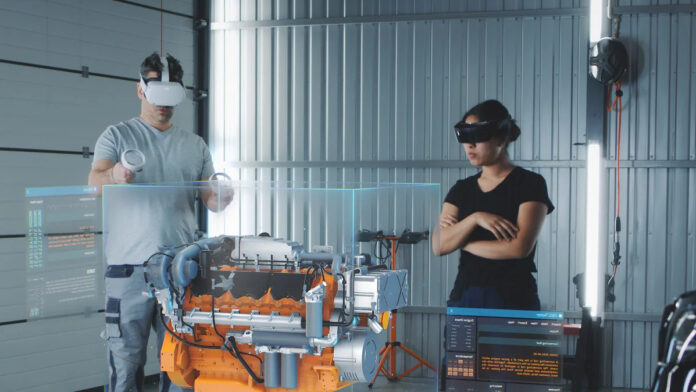Are we being hoodwinked? Has the marketing got away from us? Maybe, and maybe not. When will we see a tech vendor put its name to a report that discusses the societal dangers of sacking a workforce to make everything zero-touch autonomous – so the boardroom can kick back and watch its margins multiply, until the whole thing goes ker-splat in a metaverse clusterf*ck which is just too abstract to compute? Not here, and not today.
Instead, we have a straight-ish writeup of a press notice from Nokia and EY about how enterprises reckon they are already seeing value from their ‘industrial metaverse’ deployments. You what? Yes, you heard right – it’s that modish and meaningless Facebook-coined catch-all for digital transformation, which some of us promised never to write: meta-flipping-verse! The pair define it as a “fusion of the digital and physical worlds” – like the concept is novel.
And like it is being sold to enterprises that way: metaverse-as-a-service? Maybe it is, but it is hard to believe. It just sounds like iterative digital-change, surely (?), pulling together nominal infrastructure out of cellular-based 5G, sensor-based IoT, server-based edge/cloud compute, and analytics-based AI – with all the hardware and software gadgetry on top for enterprises to be able to make use of the volume and variety of collected data.
We know this already, of course – the first rule of 5G-club, and all of that. So, for the purposes of this article, we will replace the term-no-one-shall-say with the term-we-all-know-and-use: digital change, or even ‘digital twin’. Which are perfectly adequate labels, already – even if Nokia and EY say that only two percent of the “business leaders” they polled (17 out of 860) think the term is a “buzzword or fad”. Who are these leaders, exactly? The chief meta-wallies in key customers?
You’ll forgive the cynicism; maybe it’s the side of bed we rolled out of, or maybe it’s just that we’ve been around the block – too often, and with more head-spinning regularity. Maybe it’s that we just don’t want to play the game like that. The point, say Nokia and EY, is – wait for it – that enterprises that have kickstarted their change-motors are seeing more benefits than those that are still kicking the tires. Well, hold the front page; the drugs really do work, goes the headline.
The verdict is that companies – from six different countries – that have “already deployed [digital-change tech]” are “seeing more reported benefits than those still in the planning phase expect”. The subtext, then, is that the reality of this wicked new-tech combo is outrunning its promise. The drugs work even better than advertised – is the headline, actually. These business leaders are realising a 15 percent “benefit” in capital expenditure reduction.
They are also seeing a 10-percent “benefit” in terms of sustainability, and a further nine percent benefit with “safety improvement”. So says the duo’s new XXX-at-Work study! “The industrial [version of digital change], particularly, is expected to deliver on and beyond expectations,” they said in a statement. So, it’s just another Industry 4.0 story, then – being led by the US, the UK, and Brazil, with about two thirds (65, 64, 63 percent) of respondents with at least one MV (mystical-verisimilitude; oh give me strength) use-case in action.
Ironically, perhaps (if these figures mean anything, and our own conclusions carry); Germany – the home of Industrie 4.0, where industrial transformation is an original part of 21st century government policy; which played host to Hannover Messe a couple of months back, where all the talk was about digital-physical industrial systems, and where the view of industrial-grade 5G, say, is failingly pragmatic – is further behind at 53 percent.
Maybe German enterprises respond less well to the term, also. More curiously, Japan and South Korea, with sci-fi cellular infrastructure and hard-nosed Industry 4.0 schemes, are both on 49 percent; maybe they, too, are less inclined to buy into western marketing guff, and just want to get the work done, better and richer. The global par-average at the first hole on the Industry 4.0 fairway is 58 percent, the story goes; basically any other enterprise (94 percent) planning to take a swing will tee-off in the next two years.
Just in case we have this all-wrong; the Nokia/EY definition reads: “The enterprise [XXX] is driven by demand for better digital collaboration and communication tools. It will envelop the core productivity applications that make business function and allow for the next generation of virtual connections. The industrial metaverse is characterised by physical-digital fusion and human augmentation focused on industrial applications.”
It says these applications include digital representations of physical environments, systems, processes, and assets, which “participants can control, monitor and interact with”. Which, again, just sounds like a digital twin/thread sprung by a bunch of standard change-tech. And, actually, these business leaders cite cloud computing (72 percent), AI/ML (70 percent) and network connectivity, including private 5G (70 percent), fibre broadband (68 percent), and (!) public 5G (67 percent) as the “most important key technical enablers” for whatever it is we are all talking about here.

